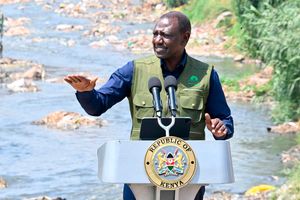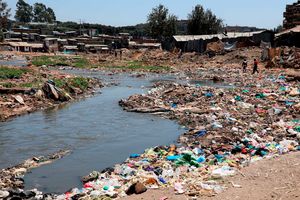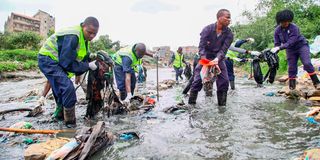
Members of Komb Green Solutions clean up a section of Nairobi River in Korogocho, Nairobi, on October 10, 2024.
Every rainy season, the Nairobi River wreaks havoc for Sharon Nyambu. She knows only too well that moving out of her shanty in Huruma would be in her best interest - but she says she cannot afford to live anywhere else.
Sharon sells second-hand clothes just 10 metres from the foul-smelling waters. News of a grand new project to clean up the river and develop its banks has brought a mix of hope for a better life and fear of the unknown.
“Sasa tutaenda wapi? (Where will we go?)” she asks, adding that being moved would mean more than losing a structure - it would threaten her entire livelihood.
Dominic, who runs a modest carwash and cybercafé - small ventures that have kept him afloat amid Nairobi’s unforgiving economic currents - has never called any other place home in the city apart from Riruta Muslim Village in Dagoretti North.

A polluted Nairobi River
He lives in a simple structure filled with memories and daily struggles since he left Kirinyaga, 130 kilometres away, in search of a livelihood. When the Nation team visited him earlier this week, he was unaware of the sweeping plans to regenerate the Nairobi River - plans that could change his life, for better or for worse.
The two are among thousands of residents facing possible displacement along the Nairobi River corridor, following a recent notice from the Nairobi City County government that declared a 60-metre buffer zone along the river as a Special Planning Area (SPA).
The goal? To pave the way for a massive clean-up and beautification initiative - billions of shillings’ worth of infrastructure and housing projects.
The move effectively doubles the existing 30-metre riparian boundary, with the additional 30 metres designated as a development corridor.
“The plan will provide a framework for river regeneration, flood hazard mitigation, riparian land use, and redevelopment - including infrastructure development, social and affordable housing, and associated physical and social infrastructure,” read the 6 March notice from City Hall.
“It will also encompass a financing structure for the development of the special planning area.”
But the announcement has only deepened anxiety among affected communities.
Misinformation
“People are concerned about losing their properties, being forcefully evicted, or displaced without compensation,” said Henry Ochieng, CEO of the Kenya Alliance of Resident Associations.
“However, these fears stem largely from misinformation and a lack of clear communication, which must be urgently addressed.”
The SPA designation triggers a two-year planning process to develop an Integrated Development Plan aimed at transforming the Nairobi River into a healthy and functional waterway. Officials promise that legal notices will be issued with attention to compensation and resettlement.
The plan - part of President William Ruto’s Nairobi River Regeneration Programme - includes construction of an expansive sewer line and development of social housing. It involves multiple government agencies, including the State Departments for Environment, Housing and Urban Development, Water and Sanitation, the Ministry of Defence, Nairobi City County, and the Nairobi Rivers Commission.

A thin, rusty pipe directs untreated human waste to the Nairobi River.
Among those resisting the move is the Dagoretti District Landowners Welfare Association, whose members argue that the directive amounts to a historical injustice that threatens inherited land.
“We will continue rejecting the government’s eviction notice until we’re granted a platform to air our grievances,”said Secretary General Pius Njogu, adding that they had taken legal action to protect their rights.
In Kawangware’s Muslim Village, many residents say they are aware only of plans to clean up the river - but not of any imminent evictions.
In nearby Mau Mau area, Joyce Ayuma has operated a small clothing stall near the river for seven years. She is increasingly anxious about how the project might affect her.
During Labour Day celebrations at Uhuru Gardens on Thursday, President Ruto reiterated his administration’s commitment: “We have 20,000 young people under the climate works programme. I made a commitment to clean up the Nairobi River and build new social housing. We’ll soon increase this number to 40,000 as we move into the next budget cycle.”
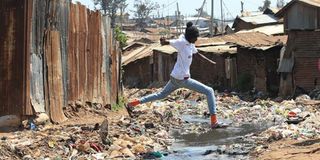
A boy jumps over polluted Nairobi River at Kibera, Nairobi, on August 2, 2020.
On April 16, Nairobi Senator Edwin Sifuna tabled a petition in the Senate on behalf of residents from the Korogocho community, who are among those facing eviction following the SPA designation.
“The residents of Korogocho are not opposed to development or environmental restoration,”
Mr Sifuna said.
“However, they deserve fairness, dignity, and a seat at the table when decisions about their lives are being made.”
Despite multiple clean-up attempts dating back to 1999, many efforts have yielded limited results or failed to stem pollution, according to Nairobi River Commission Vice Chairperson Mumo Musuva.
“This project is about reimagining Nairobi as a city where everyone has access to clean water, safe housing, and green spaces,” he said.
In addition to housing, the regeneration plan includes markets, community centres, roads, bridges, and waste management systems.
Climate change
“To restore the rivers, we must address three major challenges: sewerage, solid waste, and flooding,”
Mr Musuva said, noting that recent flooding - worsened by climate change - has highlighted how riparian and flood-prone areas have been encroached upon.
He added that most of Nairobi’s trunk sewers were damaged or destroyed during the April 2024 floods, causing raw sewage to flow directly into the rivers through broken pipes.
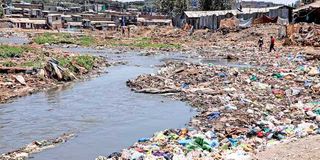
The current state of Nairobi River in this photo taken on September 15, 2024
So far, more than 300 riverine communities have been engaged. Phase One of the project focuses on a 27.2-kilometre stretch from Ondiri Swamp to Dandora Falls.
By 2027, the government envisions having completed 60 kilometres of new trunk sewers along the Nairobi River and its tributaries, a decentralised treatment plant in Kariobangi, and embanked flood-prone sections of the river. The stretch between Museum Hill and First Avenue, Eastleigh, is expected to become a riverfront district with walkways and upgraded markets around Ngara and Gikomba.


